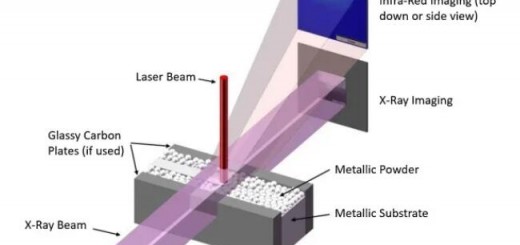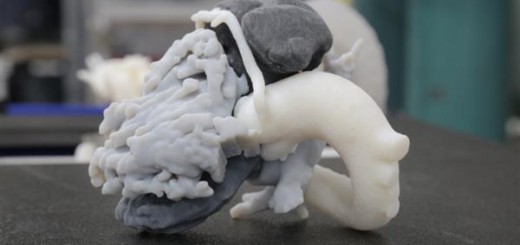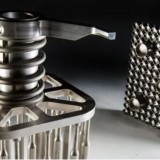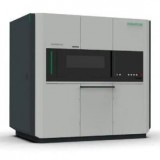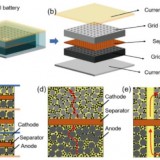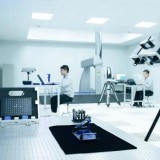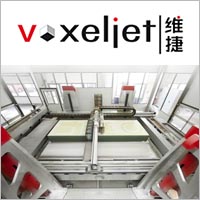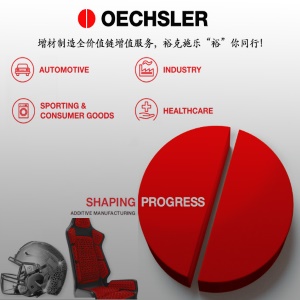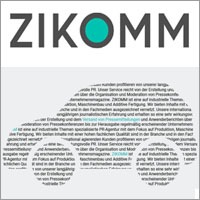从兔身上取出干细胞,放在3D打印出的支架上,在体外经过4周的培养,再接种至裸鼠皮下培养,最终可以长出所需要的软骨组织。南京医科大学附属南京医院骨科姚庆强博士介绍:“未来,我们有可能用这种技术完成人体的组织缺损修复。”该研究由江苏省数字医学学会主任委员、南医大王黎明教授领衔。
“我们已经能够应用这种技术‘制造’出兔肩关节,这为软骨再生和修复提供可能,目前,这一研究在国内骨科领域领先。”下一阶段,研究人员将在猪身上进行相关实验,一步一步与人体机能组织接近。
姚博士介绍,干细胞号称“万能细胞”,在一定条件的诱导下,它们可以分化成包括骨骼细胞在内的多种功能细胞。而研究团队所用是间充质干细胞,它们存在于骨髓血之中,能够分化为软骨细胞,就好像“装修队”。
软骨体外培养,需要以3D打印技术制造出“脚手架”——支架,在支架内富集骨髓血,并使用特定的方法诱导其中的干细胞向软骨细胞分化。并不是所有结构3D打印支架都适合该种方法的软骨生长。团队通过对比,最终选择了具有方形孔蜂巢状微结构的聚己内酯-羟基磷灰石(PCL-HA)支架。因为在培养的时候,骨髓血能够更好地与此种方孔支架结合,其中的骨髓间充质干细胞能够在支架中保留、生长,微小的蜂巢孔洞也有利于细胞生长过程中的营养交换。
姚庆强进一步介绍:“这种支架有利于特定的干细胞生长及依附,在特定的培养体系诱导下,不需要专门提炼间充质干细胞,只需将骨髓血放进支架,能长成软骨的骨髓间充质干细胞会很好的留下,成长为我们所需要的软骨。”
同时,支架在培养过程中大小稳定性强,优于常规生物可降解支架。其在培养完成接种至体内之后,在2年左右的时间内缓慢被人体降解。在降解过程中,细胞能够及时生长填充支架降解产生的空间,成长完成之后稳定性强。
目前附属南京医院骨科掌握的技术已经能够做到:从自体身上取下干细胞进行体外培养,用自己的干细胞“养成”软骨,这就避免了异体接种的免疫排斥反应、携带病毒、潜在致癌可能性等缺点。而且用3D打印技术打印出所需软骨的形状,在经过培养之后,长成的软骨大小与所需无异。
姚庆强说:“3D打印与组织工程的结合,将带来个体化植入物制作及组织工程技术的革命,将极大促进器官移植、组织修复重建及再生医学等多学科的进步。”
2014年11月24日 来源中国江苏网
Remove the stem cells from the rabbit body, the “plant” the cells in the bracket produced by 3D printing technology. After 4 weeks of culture in vitro, and then the bracket was inoculated subcutaneously in nude mice to culture, then eventually grown the needed cartilage. Department of orthopedics, Nanjing Hospital affiliated to Nanjing Medical University, Dr. Yao Qing-qiang said: “In the future, we may use this technology to repair the tissue defects of the human body.”
The study was led by Professor Wang Lin-ming, the chairman of digital medical Institute of Jiangsu Province.
“We have been able to apply this technology to ‘manufacturing’ the rabbit shoulder joint, which may be provided for cartilage regeneration and repair. This research result is in the leading position in orthopedics area in China.” The next stage, the researchers will carry out experiments in pigs, step by step, they will approach the study in human body.
Dr. Yao said that “ the stem cells are known as the “universal cell”. Under certain induction conditions, they can differentiate into a variety of functional cells include skeletal cells. The mesenchymal stem cells, which exist in the bone marrow blood, can differentiate into cartilage cells, just like a “construction team”.
To Culture cartilage in vitro, the research team need to 3D print the bracket, then they enriched the bracket with bone marrow blood, after that, they started to induce the differentiation of stem cells into chondrocytes.
Not all 3D print support structure are suitable for this kind of cartilage growth method. The team has tried several comparisons, then they finally chose to print the polycaprolactone hydroxyapatite materials with square hole honeycomb micro structure (PCL-HA). The bone marrow blood can be better grow in the square hole with stents, and the bone marrow mesenchymal stem cells can retain, growth in the scaffold. Meanwhile the tiny honeycomb holes have provided enough room to the cells in the growth process of nutrient exchange.
The bracket is biodegradable, after inoculated to the body, around 2 years, they will totally degraded. In the process of the degradation, the cell growth will fill the spaces of the bracket area.
At present, the stem cells cultured in vitro were from self body, and this can avoid immune rejection of allogeneic inoculation, to avoid carrying the virus, and also avoid the potentially carcinogenic possibility of deficiency. By using 3D printing technology, they can print the required cartilage and get the desired size of grown cartilage.
Yao Qing-qiang said: “The combination of 3D print and tissue engineering, will bring revolution to the implant industry. Also will greatly improve the progress of the organ transplantation, tissue repair and reconstruction, regenerative medicine and other disciplines progress.”
About NMU: MNU has developed a complete powerfully-supplied science and technology system encompassing various disciplines and professions, with priority areas such as reproductive medicine, cardiovascular disease, neuroscience, oncology, public health and disease control, regenerative medicine, and new drug research and development.
Translated by Kitty Wang from 3D Science Valley (51shape.com)



